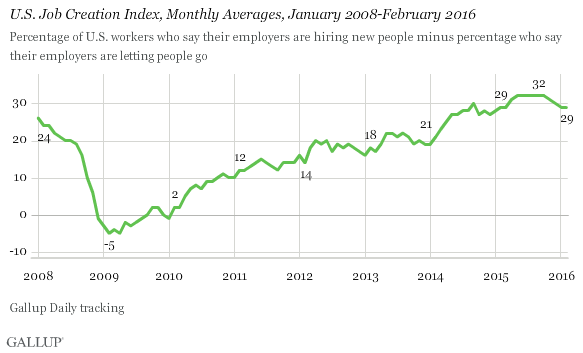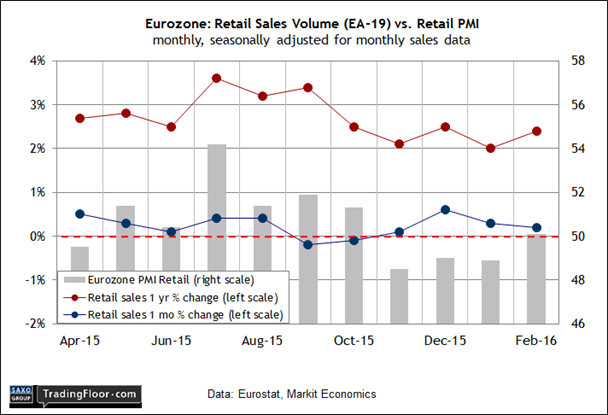- Economists project that industrial activity in Germany will tumble in February
- Will Eurozone retail spending growth roll on? Sentiment data for March may help
- Gallup’s survey on US job creation to reveal the outlook for the labour market
Germany’s industrial sector is in focus today with the monthly update on output in February scheduled for release. Later, survey data for Europe’s retail sector in March is on tap, followed by Gallup’s monthly sentiment profile for evaluating the outlook for US job creation.
Germany: Industrial Production (0600 GMT) Industrial output in Europe’s largest economy soared in January, rising 3.3% against the previous month. The hefty gain was the biggest monthly advance in six years. The question for today’s update: Is the January data noise?
Keep in mind that despite January’s surge, industrial activity slumped in this year’s opening month on a year-on-year basis (before any adjustments to the raw data).
In addition, Markit’s sentiment data for Germany’s manufacturing sector has been subdued in recent months. The sector’s purchasing managers’ index in March was a tepid 50.7, which is close to the stagnation reading of 50.0.
“With new business growth slowing further and workforce numbers falling for a second month running, it is likely that output growth will remain sluggish in coming months,” a Markit economist noted last month.
Yesterday’s data on factory orders for February provides another reason to manage expectations down. In the wake of a slowdown in global trade, orders fell a surprisingly steep 1.2% in monthly terms (after adjusting for seasonal factors and inflation).
“The outlook for the German industry remains anything but rosy,” the chief economist at ING Diba in Frankfurt told Bloomberg yesterday.
In the current climate, it’s no shock to find that analysts are expecting weakness in today’s February data on industrial activity. Econoday.com’s consensus forecast calls for a 1.9% slide in output.
As a result, the unadjusted year-on-year trend is on track to stay flat to negative. If the projection is right, January's surge will look like ancient history.
Eurozone: Retail PMI (0810 GMT) Consumer spending increased in February in the euro area, marking the fourth consecutive monthly gain. Retail sales are hardly surging, but there’s a steady growth trend underway.
Indeed, the year-on-year comparison in volume terms ticked up in February to a 2.4% increase. The gain suggests that the 2% plus pace can hold for the near-term future.
Note that a key reason for the overall rise in spending was linked to higher spending in France and Spain. The improvement in those countries offset a decline in Germany, which posted lower retail sales for the second month in a row in February, according to Eurostat.
Today’s sentiment data for March will provide fresh guidance for deciding if the moderately upbeat outlook for the Eurozone trend remains intact. The last several months have been shaky on this front, although the February purchasing managers’ index for Europe’s retail sector inched above the neutral mark (just barely) for the first time in four months.
The joker in the deck is the fact that growth overall for the Eurozone remains “subdued”, which is how Markit Economics labelled the trend based on the firm’s March update of its composite sentiment data for services and manufacturing sectors.
January's surge in German industry is beginning to look like ancient history.
“The Eurozone economy failed to show any significant gain in momentum in March,” said the firm's chief economist yesterday. “With the PMI barely rising from February’s 13-month low, the region looks to have grown by just 0.3% again in the first quarter.”
In that case, next month’s official Q1 GDP report for the Eurozone will match last year’s 0.3% quarterly pace for Q4.
Consumers, however, appear inclined to keep pushing spending higher, or so recent numbers suggest. Today’s PMI update for the retail sector in March will provide a valuable update for deciding if that narrative still applied for Q1’s closing month.
US: Gallup Job Creation Index (1230 GMT) Monday’s updates of two labour market indices imply that US job growth is headed for another rough patch in the second quarter.
The March data on nonfarm payrolls suggest otherwise, but digging deeper into a spectrum of indicators looks a bit worrisome, based on last month’s readings for the Federal Reserve Bank’s Labor Market Conditions Index and the Conference Board’s Employment Trends Index.
Today’s monthly survey update that focuses on the outlook for creating jobs will provide more context for deciding if a cool spring awaits the data for payrolls.
Recent history for Gallup’s benchmark already points to a modest deceleration. The Job Creation Index held steady at 29 in February, but the reading reflected a decline from last October’s record high of 32.
“The percentage of workers who say their workplace is hiring is down slightly from where it was over the summer, but is similar to what was found in January,” Gallup noted last month.
Today’s update will provide more perspective on the near-term outlook for the labour market. An unusually weak reading would support the argument that job growth is due to slow in the months ahead.
But don’t be surprised if the status quo prevails. In another survey report published yesterday, Gallup advised that “Americans were slightly more confident in the economy in March than in February.” That’s a clue for thinking that today’s release won’t provide any dramatic changes beyond what we already know.

Disclosure: Originally published at Saxo Bank TradingFloor.com


